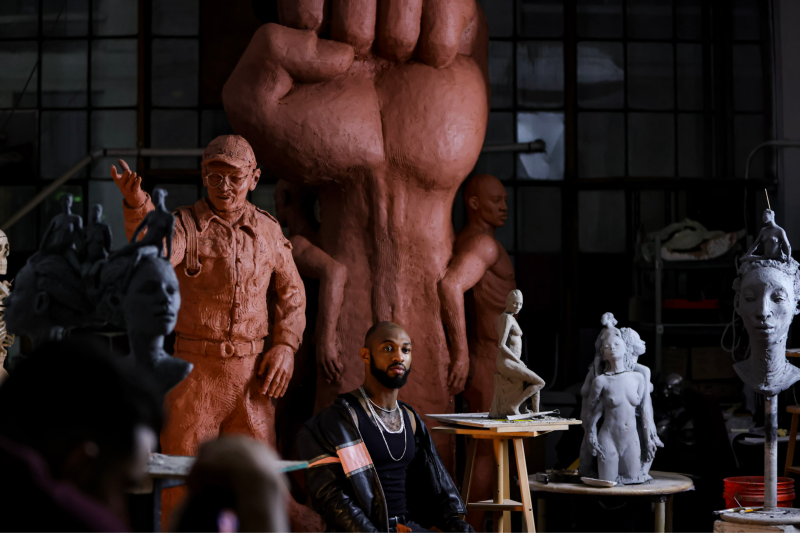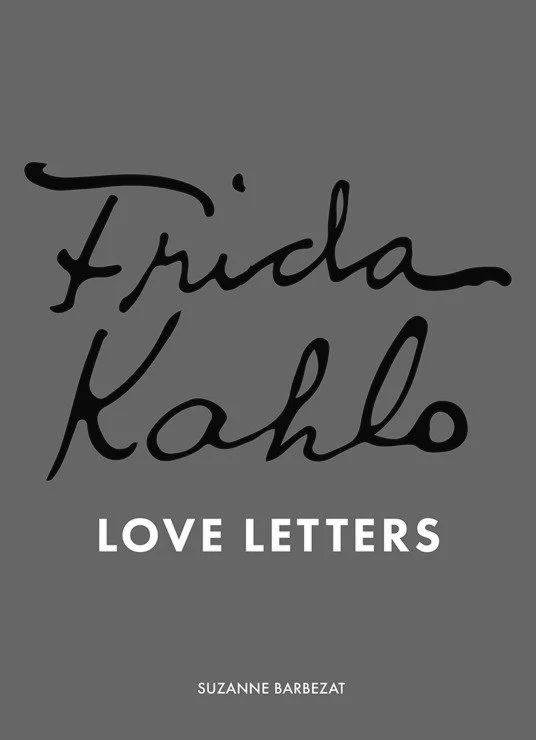Timelessness & urgent relevance in the works of AUSTEN BRANTLEY
Austen Brantley is a Detroit-based artist whose figurative sculptures and public projects venerate Black cultural figures. Drawing from Greek and African cultural traditions, Brantley’s sculptural work weaves together elements of ancient history within a contemporary context to underscore modern-day struggles and the enduring resilience of the human spirit, especially underrecognized Black figures and historical moments in the US.
Brantley also works extensively on public art installations that speak directly to the communities they are a part of, including a public art statue commemorating the Tuskegee Airmen in Detroit, which became the center of a story last fall when it was stolen and defaced. It is currently being repaired.
Brantley has several more commissioned public art statues in the works this year for the City of Madison, WI, the City of Detroit, MI, and a permanent installation honoring the first five Black students to attend East Tennessee State University, expected in the fall of 2025.
Interview by Isabel Hou
Your sculptures often blend elements of classical Greek aesthetics with African cultural references. Can you walk us through your process of merging these traditions—what draws you to each, and how do they come together in your work?
I think it’s not only Greek aesthetics. It’s more about paying tribute to classical art at large because I think that’s what we see the most. When we look up art, that’s the most popular thing that’s going to come up, even though it’s so expansive and that classical period of art is very influential in a lot of artists’ work. For me, it’s really important to be a bridge to other cultural expressions of art so that everything is more inclusive and combined.
Eternal Beauty, 2024 Ceramic with wood stain on granite base 18 x 6 x 6 inches
Are there particular motifs, forms, or philosophies from Greek and African art that you find especially complementary? Where do you see tension or contrast between the two, and how do you navigate that in your practice?
In 2021, I was traveling in Greece and was fascinated by the symbology of ancient artifacts. They’re very personal, and that’s true in all art no matter where in the world. These objects are very personally made and handcrafted. I like how all of the imagery and symbols are so distinctive, which ties back to mythology.
I’ve seen a lot of places when I’m traveling. I haven’t been to Africa yet, but I see those same kinds of accents and symbols that inspire me to create my own. There are differences, of course, because they’re different cultures, but there are also similarities. I see that in all art history and in all history itself—there are always small congruencies whenever I see small artifacts, sculptures, and pots. I think it has a lot to do with their purpose.
Senufo Presence, Ceramic stoneware, 20x11x9 in, 2023
In your view, what stories or cultural values are lost when these two traditions are treated as separate or hierarchical, and what possibilities open up when they’re in dialogue?
In history some things are more front and center, like Greek classical art, while others get glossed over, like the ancient Senufo people of Côte d’Ivoire. As a professional artist, I feel it’s up to me to look at both and be a bridge between them.
Power in the Struggle, bronze and granite base, approximately 11 x 6 x 6 ft, Freedom Monument Sculpture Park, Montgomery, AL
Your statue, Tuskegee Airmen Memorial, was not only a tribute but became a flashpoint when it was vandalized. What did that act—and the process of restoration—teach you about the vulnerability and resilience of public memory?
When that statue got vandalized, it was a big wake-up call for me. I realized that people don’t see my art the same way I do. I see it so personally, and the fact that it got more attention when it was destroyed versus when I put it up, taught me a lot about my community and how they see art. It made me want to connect with them more and explain why I do what I do and how it’s mostly for them.
I saw jokes about it on social media, and even though some of the people here in Detroit know my work, I see a bigger misunderstanding of art in general. It’s free for any Detroiter to go to our local museum, but I can tell it’s not really taught in schools to appreciate what we’re doing. I’ve seen other artists do murals, even paintings of Rosa Parks, and still get vilified just because people don’t get what these cultural symbols mean.
I think it’s so important as an artist, especially in communities like mine. We’re creating treasures for people to care about. It’s daunting but also a huge privilege. When people destroy your work, it does hurt. I remember being 16, making sculptures in ceramics class—kids would break them or stick food on them. I was just a kid putting my heart into my art—and I still am. What I learned is that people might break my heart, but they can never break me. That’s the most important thing.
Tuskegee Airmen Memorial, Bronze and granite base, approximately 6 x 3 x 3 ft, Rouge Park, Detroit, MI(1)
What motivated you to restore the statue?
I specifically sculpted Alexander Jefferson, who was a community activist and a hero to me. He fought in World War II and surprisingly said that he was treated better by the Nazis in Germany than when he came back here. I wanted to pay tribute to his story and challenges he faced both abroad and here at home.
When I first made the statue, it felt rushed. I’m mostly a self-taught artist, so doing these major commissions is a big feat for me and sometimes I don’t have the right support. It can feel like people don’t care how important the work is—if they don’t care when it gets destroyed, they don’t care much when it’s being created, either.
It taught me that whenever I make something, I want it to deserve its permanence. So, when I went to the police, it gave me a chance to fix what I’d done before, and I appreciated that opportunity.
Bright Future, Ceramic with glaze on granite base, 20x8x8 in, 2024
With the current political climate—including book bans, curriculum restrictions, and attacks on public memory—how do you see your role as a sculptor of public monuments evolving?
There’s a lot of rules when it comes to doing these pieces and sometimes I don’t like that. What I appreciate about Detroiters is that they give me a lot of freedom and trust with the monuments I make—that’s a huge privilege and responsibility.
At the same time, I love making pieces that come purely from my own vision, and those should be monuments, too. I’m not afraid to do that, but I do feel cautious when working with committees—I wonder if they understand how important it is to let voices like mine come through.
Boy Holds Flower, Bronze, 28 x 23 16 in, East Canfield Art Park, Detroit, MI
What responsibility, if any, do you think public art has in preserving histories that are being threatened or rewritten—and how does that shape the pieces you’re working on this year?
Every artist must tell the truth. It’s hard to lie to a piece when you’re creating. I don’t agree with art being made for propaganda. If I’m being commissioned by something, I’ll tell the truth about how that committee made me feel. You’ll be able to see it in my work. Every piece I make has its voice, tone, or feeling, and that visual language says everything I need to say about the situation.
Held, Ceramic with bronze oxide coating on rotating base, 44x26x15 in, 2024
You’ve spoken about wanting your work to be both timeless and urgently relevant. What themes are you hoping to elevate in your upcoming public projects, especially with your permanent installation honoring the first five Black students to attend East Tennessee State University, expected in the fall of 2025?
It’s an amazing project because I’ve had to learn a lot about what those students went through. The best part was having fun creating those pieces. I think they make a powerful statement when they’re all together—it’s a heavy piece in terms of emotions.
Finally, when someone views one of your statues—whether it’s inspired by ancient myth or modern history—what do you hope they feel, question, or carry with them afterward?
I think that we live in a world where people feel stuck and don’t follow their dreams. I hope that just creating the statue inspires people. I’m self-taught, I’ve worked hard to create anything, and even when the world was pressing down on me, I still became an artist.
As you mentioned, I’m sculpting five students who were the first to desegregate ETSU. The whole piece is an act of resilience and defiance. It’s about telling a story of adversity. Whenever I’m creating anything, I feel a strong why. I want people to know that they can achieve their goals. It’s tough, but those special gifts and talents we’re given matter. They provide us with purpose. That’s mine, and through my work, I get to honor people who lived that, too.
Did you like what you read here? Please support our aim of providing diverse, independent, and in-depth coverage of arts, culture, and activism.
Isabel Hou is a graduate student at Columbia University's School of International and Public Affairs and a Cornell alumna with an interest in policy, governance, and emerging technologies. A lifelong artist, she is passionate about storytelling and highlighting creative voices. In her free time, she enjoys skiing, cooking, and New York’s arts and culture scene.













